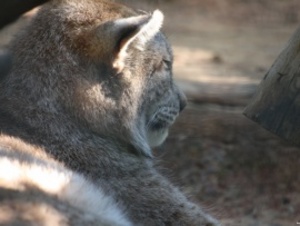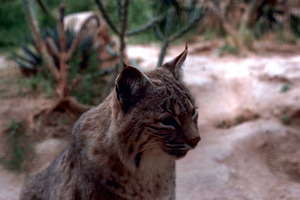Here are 25 interesting and unusual facts about the nature of cats, scientific information presented in a humorous and easily understood style.
1.
There are three basic types of cats: big cats (such as the lion and the tiger), small cats (such as the lynx and the bobcat), and domestic cats. They are not necessarily grouped according to size like the names would imply. Some small cats are smaller than a house cat and some small cats are as large as a big cat. The evolutional emergence of small cats occurred at the end of the last ice age about 12,000 years ago. The modern domestic cat was created about 4,000 years in Egypt by human feeding and taming of small wild cats. This domestication provided the Egyptians with an efficient natural mechanism for controlling mice and rat infestation.
2.
Cats leave their signature by using scent glands located on the forehead, side of jaw, paws, and tail. This is how cats communicate in the absence of physical contact. They convey the boundaries of their territory, identify their property, and even mark their owners. Cats clearly consider themselves as owners'”even of their caretakers.
3.
Friendly cats sniff one another at glands around the head and mouth. They may then combine scents by rubbing against each other. But cats have no need to develop social rules of a pack for hunting. Their groups are less cohesive and are primarily related to breeding and the raising of kittens.
4.
Kittens are born blind and deaf. These senses develop four to fourteen days after birth.
5.
For the first few days of life, kittens only sleep and suckle. Claiming a nipple of its own'”against any competition from a liter-mate'”a kitten will push with its forepaws on either side of the nipple. This presumably stimulates milk flow. The action is mimicked in adulthood as the grown cat will kneed on fluffy areas while purring contentedly.
6.
By six weeks of age, cats begin playful acts that mimic hunting behavior. They progress from pouncing to patting followed by chasing and leaping. By twelve weeks of age the cat has learned the skill of hiding and then attacking.
7.
A cat’s eyes face forward to accentuate its stereoscopic vision. This explains the extreme accuracy in judging distances for jumping and pouncing.
8.
A cat has excellent peripheral vision. However, because cat eyes do not move freely, the cat must turn its head and sometimes its body in order to bring objects into sharp focus. Cats consider a direct stare at them to be threatening. So it’s best not to look directly into the eyes of a cat. If a cat catches you doing this, blink slowly and then gaze into an area in which you only look at the cat peripherally.
9.
A layer of tissue in the eyes of a cat'”called the tapetum lucidum'”reflects light a second time through the cat’s retina. This permits the cat to see in one-sixth the amount of light required by humans.
10.
In addition to an upper eyelid and a lower eyelid, a cat has a third eyelid'”called a haw'”located toward the nose. When a cat is ill, there is a contraction of fatty tissue around the eye socket. As the eye retracts slightly into the socket, the haw is exposed, indicating the cat’s illness.
11.
The upper hearing range for a cat is 65 kilohertz. This permits hearing the high-pitched sounds of prey. This frequency range for hearing by a cat is two octaves higher than a human. But the cat’s hearing is less sensitive at lower frequencies.
12.
A cat’s ears can rotate 180 degrees'”independently of each other.
13.
The cat has an acute sense of smell and a much larger olfactory area of the brain than normal in animals of its size.
14.
There is an olfactory organ in the roof of a cat’s mouth'”the Jacobson’s organ. It is a small pouch. A cat parts its mouth and raises its head to savor scents.
15.
A cat senses temperature by smell and will rarely burn its nose or mouth. A cat avoids touching anything until it is smelled first.
16.
Even docile and well-fed cats will hunt when given an opportunity. They will customarily bring captured prey to their caretakers as a sort of reciprocal reward system.
17.
Cats will nap for 16 hours per day. About forty percent is a deep sleep with a slight decline in blood pressure and a relaxation of the muscles. About sixty percent is REM sleep when dreaming occurs.
18.
Only domestic cats will hold their tails in the air while walking. Wild cats walk with their tails down and between their legs. A tail that is straight or twitching lightly is a sign of contentment. A tail that is lashing from side to side is a sign of annoyance. If a cat is standing still with its tail straight down and not moving, it is a certain sign of imminent attack.
19.
Cats have over 100 vocal cords. This compares to one pair in humans. But cats will only make those “meow” sounds at humans and other non-cats. They communicate with other cats mostly by smell, with occasional verbal noises consisting of various growls and hisses.
20.
Cats walk by moving both right feet and then both left feet. Most four-legged mammals walk by moving the front right with the back left followed by the front left with the back right. Giraffes and camels are the only other mammals to walk like cats.
21.
The unusual walking pattern along with a tail containing over 20 bones permits the cat to balance while walking on narrow surfaces.
22.
The clavicle of a cat is not attached to other bones. This lack of a functioning collarbone permits cats of normal body weight to slip through openings that are no smaller than its head.
23.
The nose of a cat has a ridged pattern, unique to each cat just like a human fingerprint.
24.
The female starts the mating ritual with an evocative smell and call. She then rolls playfully in front of her potential mate'”or several mates who will fight over her. When the mating is finished, she moves to attack the male, who leaps away quickly.
25.
The penis of a male cat has a barb that causes him to stay attached to the female during intercourse. It also explains why the female is a little uncomfortable and ready to lash out at the male when he’s finished. But it doesn’t explain why she will come back for more. A female cat can easily produce 100 kittens during her lifetime'”with a little help from various male cats. The whole bizarre ritual of feline mating is perhaps another reason the Egyptians elevated cats to their high stature in worship.



![Housebreaking an Older [Male] Dog 300_52285](https://karla.news/wp-content/uploads/2023/08/300_52285-150x150.jpg)